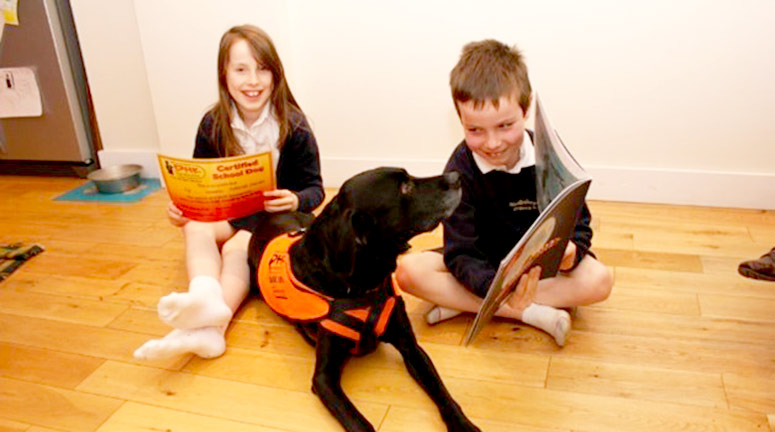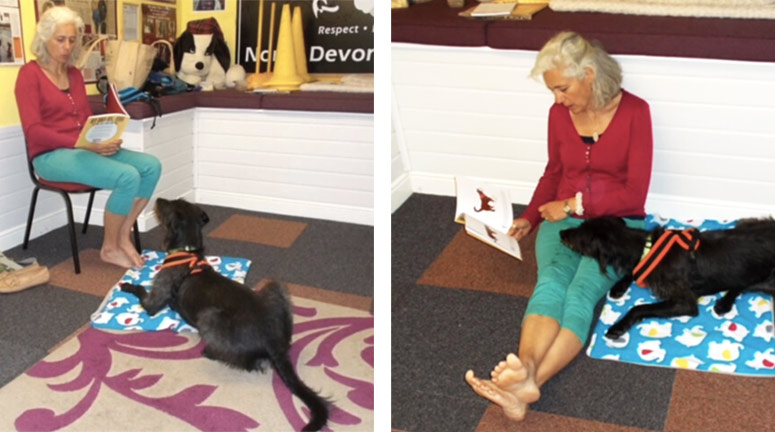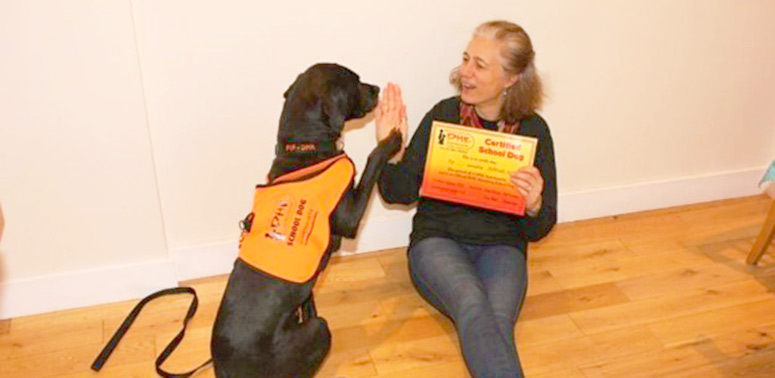By Dr Wendy V Browne | 21 February 2023
This week I spoke to Deborah Neame about educational assistance dogs and how they have helped promote wellbeing of school children and their families.
How did you get involved in educational assistance with your dog? Tell us about your journey.
Deborah: Many, many years ago I read an article in the paper about Dogs Helping Kids in schools. I am passionate about helping children who, for whatever reason, don’t follow the mainstream. I was one of those children. Of course, I also had a dog that I knew would excel at being with young people!
Both of my dogs became part of a truly amazing organisation called ‘Dogs Helping Kids’ (DHK)1, where their primary aim is to ‘educate, help and support children and teenagers of all ages, backgrounds, sexes and abilities, by training carefully selected dogs to an incredibly high standard to work in the school, college and library environment as both educational and therapeutic aids’2. Then very sadly due to lack of funding during Covid, DHK had to close its doors.
While there are other organisations who promote having dogs at school, to my knowledge, none of them insist on the rigorous training that I underwent with both of my dogs. As the press will testify when something goes wrong with a dog, it can be catastrophic. As anyone who has attended puppy or dog training will realise, the training is not for the dog, it is for the human. Recognising the subtle signals your dog is constantly communicating with you allows you to manage their needs, and really engage with the often parallel behaviours of the children.
The training is rewarding in itself, it stretched me in ways I did not expect, and the joy of seeing your dog become this amazing assistance to facilitating change in young people is, well, it’s a privilege.

Can you tell us about educational assistance dogs and how the scheme promotes wellbeing among children in schools?
Deborah: The founder of DHK, Tracey Berridge, is an incredible lady who is so passionate about linking education through the medium of dogs.
The dogs selected are calm and willing to be read to by a child. They are non-judgemental, provide unconditional acceptance and are amazing listeners. Having this sort of a companion is particularly beneficial for children who have academic and/or social challenges. The dogs really help to instil a sense of support and comfort in the children.
The impact of dogs in schools on children and teenagers in the educational environment is truly amazing and often life changing.
Academic research has shown that dogs in the school context have produced a range of benefits to children, including increased literacy skills, confidence, self-esteem, socialisation, attendance, as well as instilling a sense of responsibility
(e.g. Kirnan & Ventresco, 2018; Kropp & Shupp, 2017; Sorin, Brooks & Lloyd, 2015).

Can you give us some examples of where you have seen your dog positively impact on a child and/or family?
Deborah: I have lost count of the number of times I have seen the most incredible connection and change in the children that I have worked with.
I have had so many teachers stand open mouthed at what the child has achieved with either of my wonderful dogs. ‘I have never done that before with them’, ‘I have never got them to do X or Y’, ‘this is the first time I have seen…’, and on and on.
I generally don’t ask too much about the background of the child, it often muddies the waters. I am not an educational physiologist, so less is often more! I have a rough plan of what I might achieve, and as most educators will recognise, that plan may get binned in the first few minutes. Examples of positive impact include:
- I recall one girl who was scared of dogs, to the point of running across the road regardless of traffic to avoid them. Two sessions later of confidence building, understanding what the dog is saying, with techniques of what to do if approached by an unwelcome dog, she was asking if she could come and take my dog for a walk with me. The girl’s mother was in tears, she had been terrified that her daughter was going to have an accident avoiding dogs.
- I worked with a boy who wouldn’t come to school, and often had to be dragged screaming and kicking into the classroom. On dog days, he got himself up and dressed, remembered his reading book (and a dog biscuit), and calmly came to school. The relief on those days for the mother, well you can imagine.
- In a group of young offenders in a high secure prison unit, one lad sat on the floor stroking my dog and asked me loads of questions about her. He said he wished he had a dog because they make you so calm. I talked with him about managing escalating behaviours that are unhelpful, using my dog as the learning vehicle. Being in a prison was an eye-opener for me, and for my dog, it was just another day with people.
- I also worked with a teenage lad with Autism, extreme anxiety, and who had dropped out of school. I trained him, to ‘help me’ train my dog. The educational spin offs of doing this was amazing, he was way too wise to accept that this was dog therapy for him! His self-esteem rocketed after seeing that what he was learning, he was able to put into practise; that was fabulous. He is a very bright lad and became really interested in how you could train a dog to do useful things around the house.
- There was a boy with Down’s Syndrome, such a delightful and naughty boy! When with my dog, it was the first time he was in charge and able to make his own decisions about what happens in his lesson. We would go all over the school with a mini dog show of tricks he designed, showing anyone who would stop, including once where we burst in on an important meeting of Heads. Luckily, they were gracious enough to watch as he showed off his new-found skills!
- There was a girl with very low self-esteem, who wouldn’t speak, and I got her to work with the dog using hand signals, which she loved. She sat and silently read and showed pictures to my dog Jess. Then, one day, she read aloud to her.
- I worked with a boy with severe Autism, who was terrified of the new hand dryers in the toilets, so he wouldn’t use the toilets, with resulting consequences. Through asking him to ‘help me’ with my dog who was ‘scared’ of the noisy dryers, we were able to get him further and further into the toilets, then finally in with the dryers going. Needless to say, the dog couldn’t care less about the dryers.
I could go on, there are children in my village who still now say ‘Are you the lady with the dog? I read to your dog when I was little’. Reading to my dog might be the only time a child reads outside of scheduled time with a teacher.
Is this a scheme which you think could be rolled out more widely?
Deborah: A resounding yes! With the increasing mental health problems young people are experiencing, often alarmingly early, we need to be looking for powerful and lasting interventions to help and support them at all stages through their educational experience.

About the author
Wendy V Browne
Wendy V Browne is Andrew & Virginia Rudd Teaching Associate in Developmental Psychopathology & Education Practice at the Rudd Centre, Faculty of Education, University of Cambridge. Learn more about the exceptional work that the Rudd Centre does and follow for the latest updates.
- Follow us on Twitter: @RuddCambridge
- Rudd Centre website
Share this page
Further Information and Support
References
Kirnan, J. P., & Ventresco, N. E. (2018). Developing literacy skills in children through interaction with dogs (pp. 153-178). Children, Dogs and Education: Caring for, Learning Alongside, and Gaining Support from Canine Companions. New York, NY: Springer.
Kropp, J. J., & Shupp, M. M. (2017). Review of the Research: Are Therapy Dogs in Classrooms Beneficial? In Forum on public policy online (Vol. 2017, No. 2). Oxford Round Table. 406 West Florida Avenue, Urbana, IL 61801.
Sorin, R., Brooks, T., & Lloyd, J. (2015). The impact of the Classroom Canines program on children's reading, social and emotional skills and motivation to attend school. The International Journal of Literacies, 22, 23-35.
Useful Websites
Image attributes
- Deborah with dog: Deborah Neame
- Children with reading dog: Deborah Neame (with parental consent)
- Deborah reads to her dog: Deborah Neame

